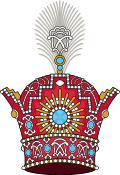
Back Khan Afrikaans Khan AN خان (لقب) Arabic Kan (títulu) AST Xan Azerbaijani خان (عونوان) AZB Хан (дәрәжә) Bashkir Хан (тытул) Byelorussian Хан (тытул) BE-X-OLD Хан (титла) Bulgarian
| Part of a series on |
| Imperial, royal, noble, gentry and chivalric ranks in West, Central, South Asia and North Africa |
|---|
 |
Khan[a] (/xɑːn/, /kɑːn/, /kæn/) is a historic Turkic and Mongolic title originating among nomadic tribes in the Central and Eastern Eurasian Steppe to refer to a king. It first appears among the Rouran and then the Göktürks as a variant of khagan (sovereign, emperor)[b] and implied a subordinate ruler. In the Seljük Empire, it was the highest noble title, ranking above malik (king) and emir (prince). In the Mongol Empire it signified the ruler of a horde (ulus), while the ruler of all the Mongols was the khagan or great khan. It is a title commonly used to signify the head of a Pashtun tribe or clan.
The title subsequently declined in importance. During the Safavid and Qajar dynasty it was the title of an army general high noble rank who ruling a province, and in Mughal India it was a high noble rank restricted to courtiers. After the downfall of the Mughals it was used promiscuously and became a surname.[2] Khan and its female forms occur in many personal names, generally without any nobiliary of political relevance, although it remains a common part of noble names as well.
Cite error: There are <ref group=lower-alpha> tags or {{efn}} templates on this page, but the references will not show without a {{reflist|group=lower-alpha}} template or {{notelist}} template (see the help page).
- ^ J. A. Boyle (1978). "Khāḳān". In van Donzel, E.; Lewis, B.; Pellat, Ch. & Bosworth, C. E. (eds.). The Encyclopaedia of Islam, Second Edition. Volume IV: Iran–Kha. Leiden: E. J. Brill. p. 915. OCLC 758278456.
- ^ J. A. Boyle (1978). "Khān". In van Donzel, E.; Lewis, B.; Pellat, Ch. & Bosworth, C. E. (eds.). The Encyclopaedia of Islam, Second Edition. Volume IV: Iran–Kha. Leiden: E. J. Brill. p. 1010. OCLC 758278456.